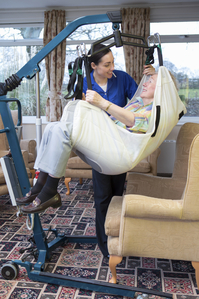The Nurse Injury Epidemic: Is The Problem Fixable?

Statistics show that hospital workers suffer injuries at twice the average for American workers. What is causing the harm and can it be remediated?
Our national health care expenditure (NHE) reached $3.46 trillion in 2012. You would think that one of the greatest assets in American health care, nurses, would be sufficiently protected from disabling injuries.
Unfortunately, nurses suffer injuries at a higher rate than construction workers. With no significant improvement in nurse musculoskeletal injury rates, the issue demands scrutiny. This paper will explore the causes of nurse injuries and what solutions – if any – can better protect the backbone of American health care.
Need help with a disability claim? Contact DarrasLaw, America’s most honored and decorated disability law firm.
The Gravity Of The Problem
Registered nurses (RNs), nursing assistants (NAs) and orderlies suffer approximately 35,000 injuries each year. The overexertion injury rate for hospital workers is twice the average for U.S. workers and for nursing home workers, it’s three times the average. For ambulance workers, it’s six times.
Back injuries are the biggest ailment in the health care workforce. Nearly two in every five nurses suffers from back pain. This may affect their ability to perform their job and ultimately, it may impact the quality of care a patient receives.
An anticipated nursing shortage is expected to reach 30 percent by 2020. This will prompt hospitals to ask an understaffed nursing population to do more, through overtime and extended hours. Many experts anticipate the added strain will increase the proportion of back injuries among nurses.
Health care workers also experience a high number of neck and shoulder injuries. We explore the sources of the injuries below, but it is no secret to nurses: Lifting and moving patients are the biggest causes of harm among nurses.
The Main Culprits
The biggest sources of health care worker injury and illness are:
- Musculoskeletal injuries
- Needlesticks and other sharps-related injuries
- Hazardous drugs
- Hazardous chemicals
- Radiation
- Infectious disease
- Violence
The nursing profession has seen safety improvements in nearly all of these categories, but one: musculoskeletal injuries. The body parts most often afflicted by musculoskeletal injury in health care workers are the back, neck and shoulders. These injuries predominantly occur when lifting or moving patients.
Moving And Lifting Patients
It is well settled that lifting and moving patients expose an RN, NA or aide to the greatest risk of occupational injury. A single patient may need help getting in and out of bed 15 to 20 times a day. Approximately 70 percent of U.S. adults are overweight or obese, so the daily stress on a nurse’s body can reach grand proportions.
Nurses must often move patients by themselves or in small teams of two or three. When the weight of an obese patient’s leg may reach 70 pounds, it is not hard to imagine the extreme torque put on a nurse’s spine. While hospitals may teach and preach proper “body mechanics” as a means of preventing back injuries, experts believe that it is not effective.National Public Radio (NPR) recently aired a program about the dangerous forces exerted upon nurses’ spines. William Marras, director of the Spine Research Institute at Ohio State University,

explained why proper body mechanics do not save nurses from injury while lifting and moving patients.
Marras cited three main reasons why nursing staff members are exposed to great risk of spinal trauma when moving patients, despite using proper body mechanics:
- It is easiest to lift an object when it is close to your body. This is impossible for nurses who are helping a patient out of bed or into a wheelchair.
- Nurses must bend over to assist patients. When the human body bends over, it disengages little bones that help us absorb forces when we are upright.
- The repetitive tasks involved in nursing cause microscopic tears in nurses’ “end plates” above and below each disk. The tears create scar tissue, which may block nutrients from entering the disk until they start deteriorating.
So if experts at the forefront of human physics believe that the forces exerted upon nurses’ bodies are unsustainable, what is the solution to the problem?
Aside from teaching proper body mechanics, employers have tried two main strategies to reduce the back injury rate among nurses and assistants.
Lifting Teams
Designated lifting teams have been a popular method for helping ease the strain on nurses’ backs. While programs differ among hospitals, these generally involve four-person teams that move patients upon request. Some nurses claim they’ve benefited from lift teams, but they involve some serious obstacles:
- Requests take time: Patients usually require moving on a “need” basis, not on a schedule. If the patient is in pain or needs to use the restroom, a nurse does not have the luxury of waiting 10 to 15 minutes or longer for the lift team to arrive.
- Understaffing: Some hospitals have hired lifting teams to show concern about injuries to their nursing staff, but they do not staff a sufficient number of lifting teams to accommodate all requests in a timely manner, if at all.
- Lifting team members become the ones with bad backs: As we discussed above, proper body mechanics do not eliminate the extreme forces involved with transferring patients. When a patient is transferred, the forces are distributed unevenly at every moment of the process. Someone is always sustaining an unsafe load.
While hospitals promote lifting teams as a way to protect the safety of nurses, they are still an impractical method of reducing injuries. The second strategy is much more effective.
Lifts And HoistsPatient lifts are the only solution that truly protects hospital workers from serious injuries when moving patients. Preliminary research from hospitals run by the Department of Veterans Affairs (VA) indicates that hoists reduce hospital lifting injuries by an average of 40 percent – and the injuries that do occur are less severe.
Many are surprised to learn that the VA is at the forefront of hospital worker injury prevention. VA nurses and staff members were suffering the same crippling back injuries as workers at other hospitals, but the hospital system viewed the problem.

differently. They did hard research and learned that approximately 2,400 VA hospital workers were injured each year while lifting patients.
Notwithstanding the humanistic ideals of protecting its workers, the VA understood that the ghastly injury total was harming the VA hospitals as well. Issues like understaffing, employee turnover and disability claims were costing VA hospitals about $22 million each year. Officials decided it was time for a change.
The VA hospitals system spent roughly $200 million reinventing the way its nurses and staff move patients. The “Safe Patient Handling” initiative involved the following changes:
- Patient lifts installed in every room a patient is treated in
- The use of floating mattresses, where air streams blow air until the mattress nearly levitates
- The creation of designated “safety champions” at each hospital who supervise and train employees to use the new equipment
Why Aren’t All Hospitals Following The VA Model?
Like most things in business, it all comes down to money and prioritizing. Every hospital official will tell you how much he or she cares about preventing nurse injuries, but it is not at the top of hospitals’ priorities. Hospitals are constrained by budgets, and when the installation of patient lifts is competing for funding against the latest, greatest surgical laser, the hospital will nearly always go with the latter.
Some hospitals have tried to make inroads in preventing back injuries among nurses, but soon learn that installing a dozen hoists throughout the building makes little difference. If a lift isn’t convenient for a nurse to use and he or she has not been trained and supervised in its use, it will not be incorporated into the nurse’s busy routine.
A comprehensive nurse injury prevention program requires lifts to be installed nearly everywhere. It also needs safety champions to teach nurses how to use the hoists and make them use them. Most importantly, it needs hospital officials to realize the magnitude of the problem and be “all in” for fixing it.
Need help with a disability insurance claim?
At DarrasLaw, we leverage more than 100 years of insurance and hard-fought litigation experience in your favor. We’ve recovered nearly $1 billion in wrongfully denied insurance benefits for our clients. Contact us for your Free Case Review.


